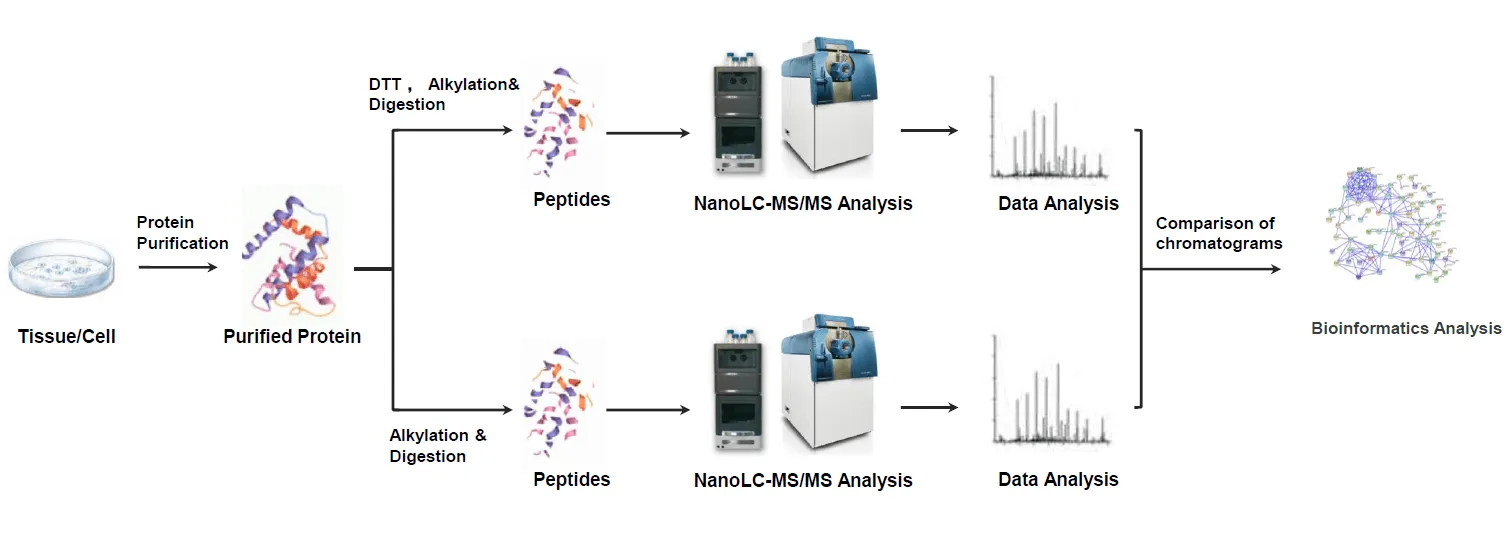Disulfide Bond Analysis Services
Disulfide bonds in proteins are covalent linkages formed between two cysteine residues through sulfur atoms. They are critical elements for maintaining the three-dimensional structure and functional stability of proteins. The presence of disulfide bonds influences protein folding, functional activity, and interactions with ligands or other proteins. Accurate analysis of disulfide bonds is essential for uncovering the relationship between protein structure and function, optimizing protein engineering designs, and advancing the development of biopharmaceuticals. In the development of antibody and protein drugs, disulfide bond analysis is used to optimize and validate the structure of candidate drugs.
Ren T, et al. Biotechnol Bioeng. 2021.
Figure 1. The Structure of Disulfide Bond
MtoZ Biolabs Disulfide Bond Analysis Services
Utilizing a state-of-the-art mass spectrometry platform, MtoZ Biolabs offers comprehensive disulfide bond analysis services that provide high-quality data support for protein structural research and functional analysis. By integrating high-resolution mass spectrometry, our disulfide bond analysis services deliver precise and efficient solutions, empowering researchers to achieve breakthroughs in fundamental research and applied development. Our service offerings include:
1. Qualitative and Quantitative Analysis of Disulfide Bonds
Accurately identify the number and location of all disulfide bonds in proteins and assess their contribution to the protein’s three-dimensional structure.
2. Disulfide Bond Topology Analysis
Using non-reducing enzymatic digestion and mass spectrometry, we comprehensively uncover the pairing patterns of disulfide bonds within proteins.
3. Dynamic Disulfide Bond Analysis
Analyze changes in disulfide bond properties under various conditions, such as redox states, temperature variations, or drug treatments, providing insights into protein dynamics.
4. Disulfide Bond Detection in Biopharmaceuticals
For antibody drugs and recombinant proteins, we detect the integrity of disulfide bonds to ensure product stability and efficacy.
5. Network Analysis of Disulfide Bonds in Complex Samples
Perform global analysis of disulfide bonds in protein complexes or cellular extracts, delivering insights into intricate protein interaction networks.

Figure 2. Disulfide Bond Analysis Workflow
Why Choose MtoZ Biolabs?
1. Comprehensive and Accurate Characterization
Using high-resolution mass spectrometry platforms such as Thermo Fisher Orbitrap Fusion Lumos and Q Exactive HF-X, we precisely locate disulfide bonds within proteins, revealing their roles in different folding states or complexes. Our services encompass a comprehensive analysis of the total number, pairing patterns, and dynamic changes of disulfide bonds in proteins.
2. Integration of Multiple Experimental Approaches
Our disulfide bond analysis services combines reduced and non-reduced sample processing with enzymatic digestion and chemical modifications to deeply analyze disulfide bond topology. Additionally, by employing quantitative mass spectrometry techniques such as TMT or iTRAQ labeling, we investigate disulfide bond variations under different experimental conditions.
3. Dynamic Disulfide Bond Studies
In protein functional studies, the formation and cleavage of disulfide bonds often accompany structural changes. Our service monitors these changes, helping clients understand the dynamic properties of proteins in biological processes.
4. Adaptability to Diverse Sample Types
Our service supports a variety of protein samples, including native proteins, recombinant proteins, protein complexes, and cell extracts, catering to diverse needs ranging from basic research to industrial development.
Applications
1. Drug Development and Quality Control
The structural integrity of disulfide bonds is a critical factor influencing the efficacy of biopharmaceuticals. Our disulfide bond analysis services provide essential insights for drug quality evaluation.
2. Protein Folding and Functional Studies
Reveal the formation and stability of disulfide bonds during protein folding, offering valuable data support for structural biology research.
3. Biomarker Discovery
Analyze dynamic changes in disulfide bonds under disease conditions to facilitate the identification and validation of novel biomarkers.
4. Protein Engineering Optimization
Optimize and design disulfide bonds to enhance protein thermal stability and activity, meeting industrial and medical requirements.
Deliverables
MtoZ Biolabs offers professional disulfide bond analysis services tailored to your specific requirements in protein research and development. Contact our expert team to design your customized solution.
MtoZ Biolabs – Pioneering Protein Research Powered by Mass Spectrometry!
How to order?







